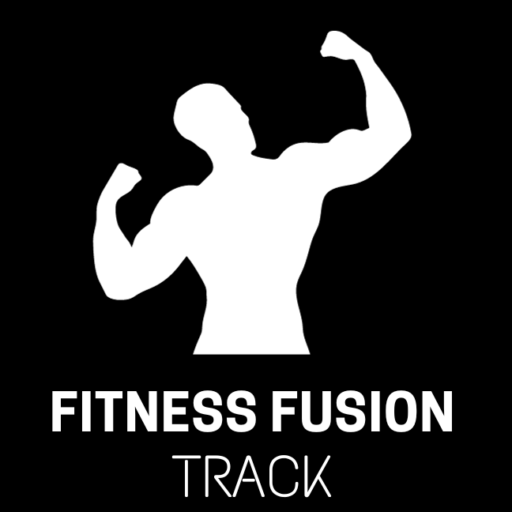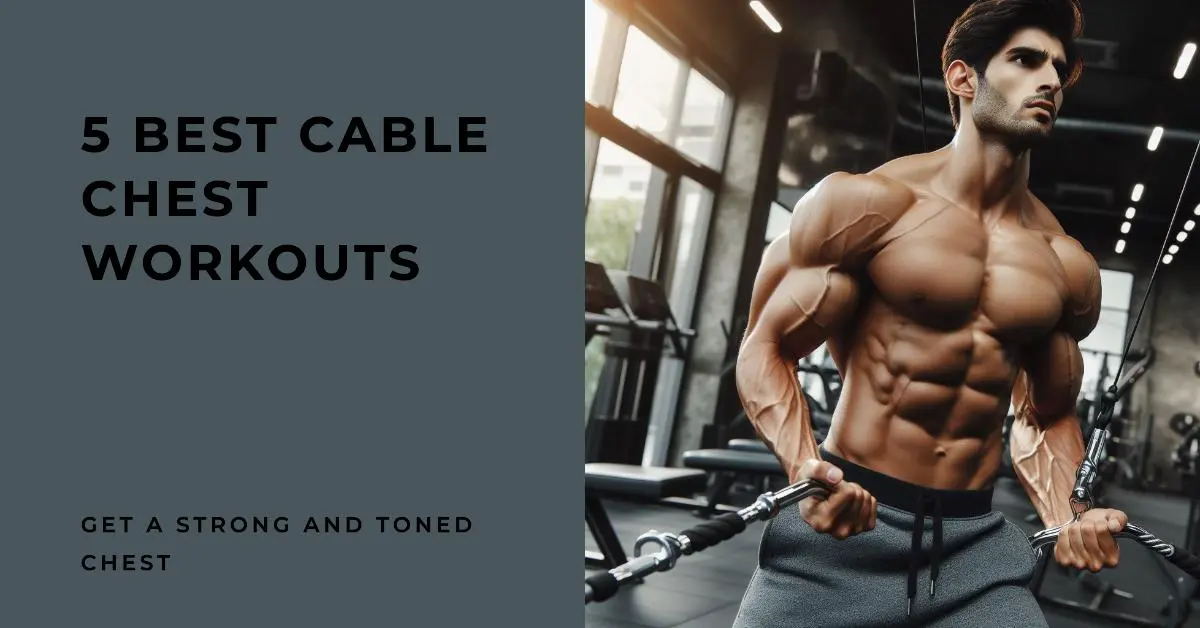Looking to sculpt a powerful chest? Look no further than cable chest workouts. These exercises offer a dynamic approach to targeting your chest muscles, providing consistent tension throughout each movement. By including cables into your routine, you can improve your range of motion and engage your muscles more effectively. In this article, we’ll explore the best cable chest workouts that will help you achieve unparalleled chest development. Get ready to elevate your chest training to new heights and unlock impressive gains!
What is a Cable Chest Workout?
Cable chest workout used cable machines to target the muscles of the chest effectively. Unlike traditional free weights, cables provide constant tension throughout the entire range of motion, leading to increased muscle activation and growth. These exercises offer versatility in targeting different areas of the chest and can be adjusted to accommodate different fitness levels. Whether you’re aiming to increase strength, build muscle mass, or improve definition, cable chest workouts provide an excellent opportunity to sculpt and strengthen your chest muscles effectively.
Benefits of Cable Chest Workout
- Increased Range of Motion: Cables allow for a greater range of motion compared to traditional weightlifting exercises.
- Constant Tension: Unlike free weights, cables keep tension on the muscles throughout the entire movement, leading to greater muscle activation and growth.
- Versatility: With various cable attachments and adjustable pulley heights, you can perform a wide range of chest exercises targeting different muscle fibers.
- Stability: Cables provide stability during exercises, reducing the risk of injury and allowing you to lift heavier weights safely.
Importance of Proper Form
Maintaining proper form during cable chest workouts is crucial for maximizing effectiveness and preventing injury. Proper form ensures that the targeted muscles are properly engaged and reduces strain on other parts of the body. Focus on keeping your back straight, shoulders down and back, and core engaged throughout each movement. Avoid using momentum to lift the weight, and instead, prioritize controlled, deliberate movements to ensure optimal muscle activation and growth.
Equipment Needed
To perform cable chest workouts effectively, you’ll need access to a cable machine equipped with various attachments such as straight bars, D-handles, and single-hand grips. Additionally, having an adjustable bench is beneficial for exercises like incline cable presses. These machines provide the necessary resistance to target the chest muscles and allow for a wide range of movements to challenge and strengthen your chest effectively.
Best Cable Chest Workouts
Cable Chest Press
The cable chest press mimics the motion of a traditional bench press but with the added benefit of constant tension provided by the cables. Attach a straight bar or D-handles to the cables and set the pulleys to shoulder height. Stand facing away from the machine, grab the handles, and press them forward until your arms are fully extended. And come back to the original position and repeat it.

Cable Flyes
Cable flyes target the inner chest muscles and are an excellent isolation exercise for sculpting a defined chest. Set the pulleys to the lowest position, and stand facing the machine with one foot forward for stability. Grab the handles with palms facing inward and arms slightly bent. Bring your hands together in a hugging motion until they meet in front of your chest, then slowly return to the starting position.
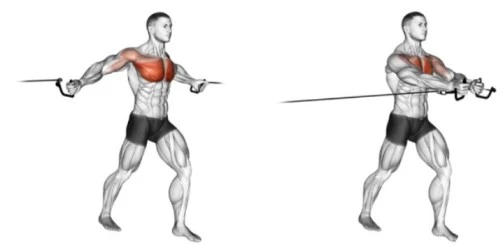
Incline Cable Press
Performing the cable press on an incline bench targets the upper chest, helping to create a balanced and symmetrical chest development. Adjust the bench to a 30-45 degree incline and set the pulleys to shoulder height. Grab the handles and press them upward at a slight angle, focusing on squeezing the upper chest at the top of the movement.
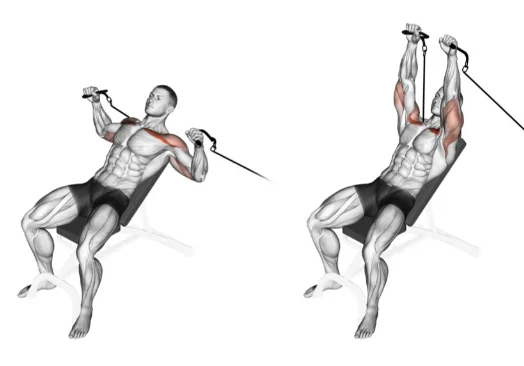
Single-Arm Cable Chest Press
This unilateral exercise helps correct muscle imbalances between the left and right sides of the chest while also engaging the core for stability. Stand sideways to the machine with the pulley at chest height. Grab the handle with one hand and press it forward while maintaining stability with your core. Repeat on both sides.
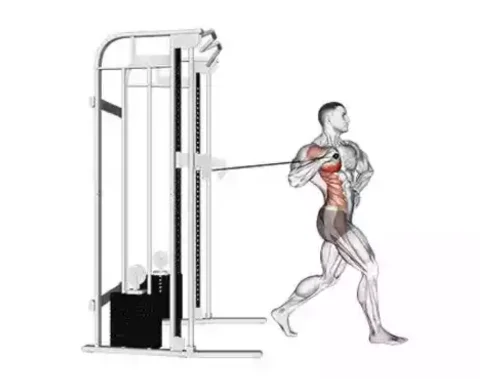
Cable Crossover
The cable crossover is a versatile exercise that allows you to target the chest from different angles, promoting overall muscle growth and definition. Set the pulleys to the highest position and grab the handles with palms facing downward. Step forward slightly, and bring your hands together in front of your body in a sweeping motion, focusing on squeezing the chest at the midpoint.
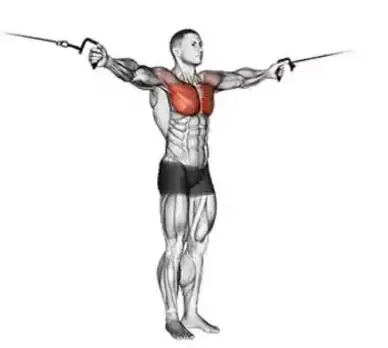
Tips for Maximizing Effectiveness
- Controlled Movements: Focus on slow, controlled movements to maximize muscle engagement and prevent injury.
- Mind-Muscle Connection: Concentrate on feeling the chest muscles working throughout each exercise to ensure proper activation.
- Variation: Include different cable attachments and angles to target the chest from different perspectives and promote muscle growth.
- Progressive Overload: To test your muscles and encourage growth, gradually raise the weight or resistance over time.
Common Mistakes to Avoid
- Using Too Much Weight: Using too much weight might result in bad form and raise the possibility of being injured. Select a weight that will enable you to complete each exercise correctly.
- Neglecting Range of Motion: Ensure you’re utilizing the full range of motion for each exercise to maximize muscle activation and growth.
- Relying on Momentum: Avoid using momentum to lift the weight, this reduces the effectiveness of the exercise and increases the risk of injury.
Sample Cable Chest Workout Routine
- Cable Chest Press: 3 sets x 12-14 reps
- Cable Flyes: 3 sets x 12-15 reps
- Incline Cable Press: 3 sets x 10-12 reps
- Single-Arm Cable Chest Press: 3 sets x 10 reps per arm
- Cable Crossover: 3 sets x 12-15 reps
Progression and Variation
Progression and variation are key components of successful cable chest workouts. To continue making progress, it’s important to gradually increase the weight or resistance used during exercises. Additionally, varying your workouts by changing exercises, rep ranges, and intensity levels helps prevent plateaus and keeps your muscles challenged. Experiment with different cable attachments, angles, and tempos to target your chest muscles from different perspectives and promote continuous growth and development.
Safety Precautions
Safety precautions are paramount when engaging in cable chest workouts to prevent injuries and ensure a productive session. Begin by warming up properly to prepare your muscles for exercise and reduce the risk of strain. Focus on maintaining proper form throughout each movement, avoiding excessive weight that could compromise your technique. Listen to your body and stop immediately if you experience any discomfort or pain. Lastly, seek guidance from a certified personal trainer to learn correct techniques and minimize the risk of injury.
Including Cable Chest Workouts into Your Routine
Including cable chest workouts into your routine can diversify your training routine and lead to significant gains in chest strength and muscle development. Consider adding cable exercises as standalone workouts or including them into your existing chest routines. Aim to perform cable chest exercises at least once or twice a week, focusing on proper form and gradually increasing resistance over time. Experiment with different exercises and variations to keep your workouts challenging and engaging.
Nutrition and Recovery
Nutrition and recovery play crucial roles in maximizing the benefits of cable chest workouts. Ensure you’re consuming a balanced diet rich in lean protein, complex carbohydrates, and healthy fats to support muscle growth and repair. Hydration is also important for optimal performance and recovery. Additionally, prioritize proper rest and sleep to allow your muscles to recover and grow. Consider including post-workout meals or supplements to replenish nutrients and aid in muscle recovery for improved performance in future workouts.
Conclusion
In conclusion, cable chest workouts offer a versatile and effective way to build strength and muscle mass in your chest. By including these exercises into your routine, you can target your chest muscles from different angles and achieve optimal results. Remember to focus on proper form, maintain consistency, and progressively overload your muscles to continue seeing progress over time. Whether you’re a beginner or an experienced lifter, the best cable chest workouts discussed in this guide will help you reach your chest training goals and unlock your full potential.
FAQs
Q. Can beginners perform cable chest workouts safely?
Yes, beginners can safely perform cable chest workouts by starting with lighter weights, focusing on proper form, and gradually increasing intensity as they become more comfortable with the exercises.
Q. How often should I include cable chest workouts into my routine?
It’s recommended to include cable chest workouts 1-2 times per week, allowing for proper rest and recovery between sessions.
Q. Can cable chest workouts replace traditional bench presses for chest development?
While cable chest workouts offer unique benefits, they shouldn’t necessarily replace traditional bench presses entirely. Including a combination of both types of exercises can lead to comprehensive chest development.
Q. Are cable chest workouts suitable for individuals with shoulder or back injuries?
Cable chest workouts can be adapted for individuals with shoulder or back injuries by adjusting the range of motion, reducing weight, and focusing on exercises that don’t exacerbate existing injuries. However, people can consult with a healthcare professional or physical therapist before starting any new exercise program.
Q. How long does it take to see results from cable chest workouts?
Results from cable chest workouts can vary depending on factors such as consistency, intensity, diet, and individual genetics. With regular training and proper nutrition, noticeable improvements in chest strength and muscle definition can be observed within a few weeks to a couple of months
